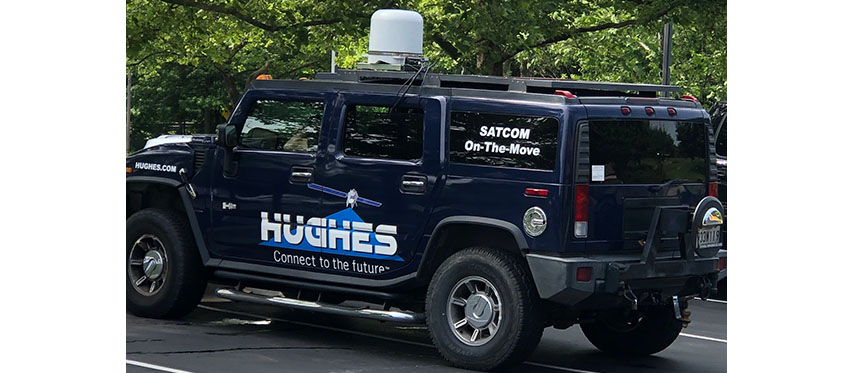DoD Gets a Look at “Self-Healing” Capabilities for More Resilient SATCOM Connectivity on the Move

If you happened to be near Frederick, Maryland in July of this year, you may have noticed a Hummer traversing the highway, emblazoned with a Hughes logo on the side and sporting satellite antennas on the roof-top. What may have looked like a scene for a new movie, was actually a test of the latest game-changing technology from Hughes.
The Hughes Defense and Intelligence Systems Division (DISD) conducted live demonstrations for the Department of Defense (DoD) of the advanced satellite communications (SATCOM) capabilities made possible by our Flexible Modem Interface (FMI) and Enterprise Management and Control (EMC) technologies. That day’s mission simulated how small terminals designed for Unmanned Aerial Vehicles (UAVs) can intelligently roam over wide areas, employing a self-healing network switching between diverse satellite networks to avoid transmission disruption and maintain connectivity. In this case, switching occurred between the EchoStar 9 and EchoStar 105 Ku-band satellites.
This latest demonstration is associated with the multi-million dollar U.S. Space Force (USF) Space and Missile Systems Center (SMC) contract, which is focused on producing an EMC (mission planning with integrated situational awareness) and FMI-enabled Aero Terminal prototype for satellite communications.
Comprising the small aero terminal is a Hughes software-defined HM400 modem and a GetSat Ku-band aero antenna using a video sensor. The self-healing terminal switches between the HM400 software-defined waveform and the ComTech DMD-2050E running the DoD EBEM waveform. Artificial Intelligence (AI) rules-engine technology uses situational data to make autonomous decisions about the terminal’s use of diverse resources. This includes the operational environment, mission plans, potential satellite access issues, and mission priority based on available services, enabling the FMI to change its configuration in near real-time. The AI-equipped autonomous terminal management agent software chooses the most appropriate modem, satellite and service provider to meet the terminal’s connectivity needs at any given time. The EMC capability also generates full PACE (primary, alternate, contingency, and emergency) plans for the missions using a similar AI rules-engine based innovation.
The July demonstration verified that if a degraded or disrupted transmission occurs, automated terminal management and control will use alternate networks to “self-heal” connections – ultimately leading to greater resiliency and enhanced interoperability across military and commercial SATCOM networks. Achieving such self-healing capabilities, within full PACE mission planning, is critical for DoD, since its current SATCOM network users must manually change communications elements if their original operational configuration does not work—whether due to interference, poor antenna angles or directional pointing, or an inability to reach a specified satellite. Often, this renders users unable to communicate, in some cases for weeks or months at a time.
“This demonstration helped the DoD understand the significant progress being made to deliver high resilience and interoperability across their communications networks using software-based automation with Artificial Intelligence and agile development,” said Dr. Rajeev Gopal, vice president, Advanced Programs, Hughes DISD. “Our military users saw firsthand how enabling a flexible interoperable architecture can improve upon existing, stove-piped networks.”
Attendees also saw that the solution helps to reduce the time it takes to get satellite access up and running. Where some teams must wait days and months to get communications, the Hughes solution can be up and running in minutes.
Since DoD spends multi-billions of dollars each year to acquire and maintain their wideband satellite communications – and given communications are essential to mission readiness – innovative solutions like this are a significant step toward meeting the needs of dynamic warfighter operations.
Hughes has been demonstrating a variety of FMI and EMC technologies for the DoD since 2018, all in support of more resilient, efficient, and cost-effective SATCOM military networks. Click here to learn more.